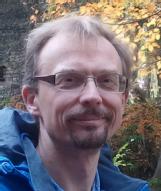WMS Events Calendar
Please see this page for MB ChB events.
BMS Seminar: Complex waves on the surface of live cells: A new pattern formation paradigm, Professor Andrew Goryachev, Professor of Computational Cell Biology, University of Edinburgh
Abstract: Biochemical oscillations that emerge from the interplay of fast positive and delayed negative feedbacks can produce propagating waves in spatially extended systems. Recently, we described actin waves on the cortex of large (~1000 µm) cells, oocytes and embryos of frogs and echinoderms, and demonstrated that they are driven by the waves of activity of small GTPase Rho, a signaling molecule known to pattern the cytokinetic furrow (Bement et al., Nat. Cell Biol. 17:1471, 2015).
A new breakthrough in this project has been precipitated by the introduction of the genetically rewired frog oocytes, in which the concentrations of molecules responsible for positive and negative feedback can be varied at will. This technical advance produced high-quality imaging data revealing oscillatory wave patterns with the complexity and diversity unprecedented in any in-vivo system and rivaling those of the established in-vitro paradigms, such as the Belousov-Zhabotinsky reaction and the MinDE system. Furthermore, I show that our model is able to predict how the experimental parameters control the succession of patterns and explain their characteristic defects and instabilities. I will show how experiment and theory can synergize to provide understanding of a dramatic oscillatory phenomenon as well as shed light on the underlying functional cellular mechanisms.
 Biography: Andrew is a computational cell biologist with a multifaceted experience and broad interest in cellular morphogenesis and pattern formation. A major focus of research in his group is on the biophysical mechanisms of symmetry breaking. Andrew obtained his PhD in modeling pattern-formation in complex chemical systems from the University of Toronto, Canada. Since then he has been working on the interface of Biology, Chemistry and Physics in academic, industrial and governmental settings. He joined University of Edinburgh in 2006 and is now a Professor of Computational Cell Biology at the Centre for Synthetic and Systems Biology, Institute for Cell Biology, School of Biological Sciences.
Biography: Andrew is a computational cell biologist with a multifaceted experience and broad interest in cellular morphogenesis and pattern formation. A major focus of research in his group is on the biophysical mechanisms of symmetry breaking. Andrew obtained his PhD in modeling pattern-formation in complex chemical systems from the University of Toronto, Canada. Since then he has been working on the interface of Biology, Chemistry and Physics in academic, industrial and governmental settings. He joined University of Edinburgh in 2006 and is now a Professor of Computational Cell Biology at the Centre for Synthetic and Systems Biology, Institute for Cell Biology, School of Biological Sciences.
